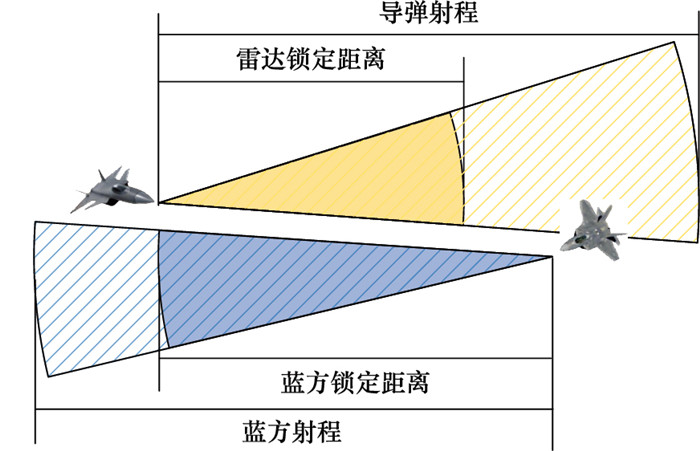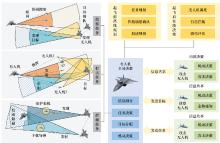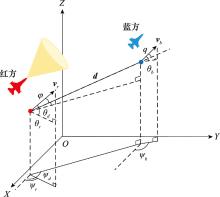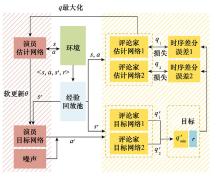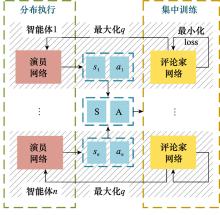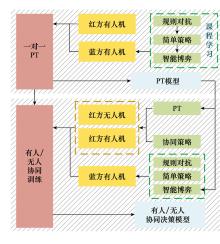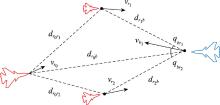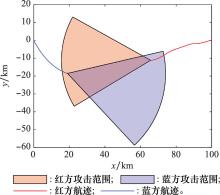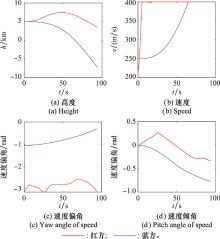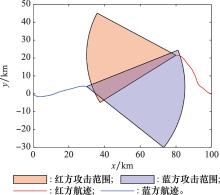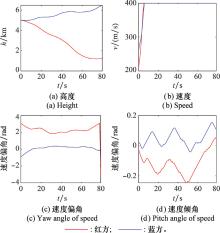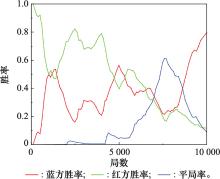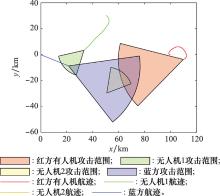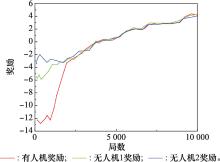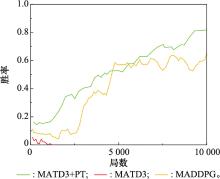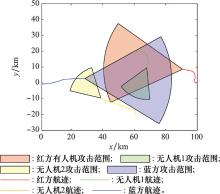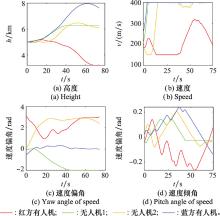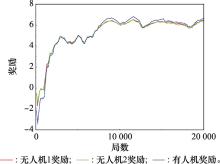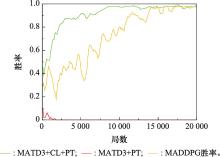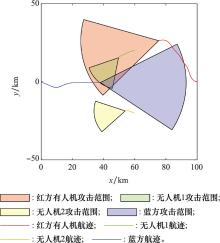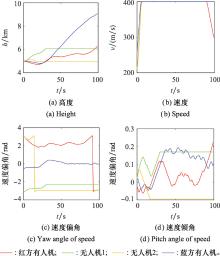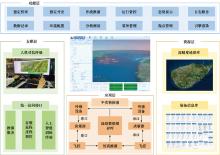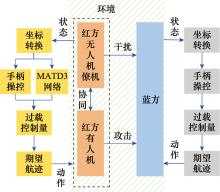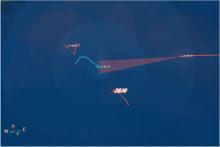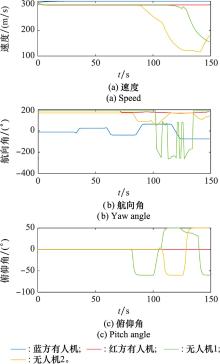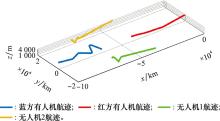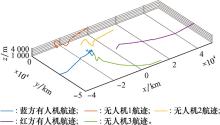Systems Engineering and Electronics ›› 2025, Vol. 47 ›› Issue (4): 1285-1299.doi: 10.12305/j.issn.1001-506X.2025.04.25
• Guidance, Navigation and Control • Previous Articles Next Articles
Research on intelligent decision-making methods for coordinated attack by manned aerial vehicles and unmanned aerial vehicles
Wei XIONG1,2, Dong ZHANG1,2,*, Zhi REN1,2, Shuheng YANG1,2
- 1. School of Astronautics, Northwestern Polytechnical University, Xi'an 710072, China
2. Shaanxi Key Laboratory of Space Vehicle Design, Xi'an 710072, China
-
Received:2024-04-26Online:2025-04-25Published:2025-05-28 -
Contact:Dong ZHANG
CLC Number:
Cite this article
Wei XIONG, Dong ZHANG, Zhi REN, Shuheng YANG. Research on intelligent decision-making methods for coordinated attack by manned aerial vehicles and unmanned aerial vehicles[J]. Systems Engineering and Electronics, 2025, 47(4): 1285-1299.
share this article
Table 1
State space"
| 状态 | 定义 | 状态 | 定义 | |
| s1 | xr0/xmax | s2 | xr1/xmax | |
| s3 | xr2/xmax | s4 | yr0/ymax | |
| s5 | yr1/ymax | s6 | yr2/ymax | |
| s7 | hr0/hmax | s8 | hr1/hmax | |
| s9 | hr2/hmax | s10 | xb/xmax | |
| s11 | yb/ymax | s12 | hb/hmax | |
| s13 | |dr0b|/dmax | s14 | |dr1b|/dmax | |
| s15 | |dr2b|/dmax | s16 | |dr0r1|/dmax | |
| s17 | |dr0r2|/dmax | s18 | θd0/π | |
| s19 | θd1/π | s20 | θd2/π | |
| s21 | θd01/π | s22 | θd02/π | |
| s23 | d0/π | s24 | d1/π | |
| s25 | d2/π | s26 | d01/π | |
| s27 | d02/π | s28 | |vr0|/vmax | |
| s29 | |vr1|/vmax | s30 | |vr2|/vmax | |
| s31 | |vb|/vmax | s32 | θr0/π | |
| s33 | θr1/π | s34 | θr2/π | |
| s35 | θb/π | s36 | r0/π | |
| s37 | r1/π | s38 | r2/π | |
| s39 | b/π | s40 | nxr0/nxmax | |
| s41 | nxr1/nxmax | s42 | nxr2/nxmax | |
| s43 | nyr0/nymax | s44 | nyr1/nymax | |
| s45 | nyr2/nymax | s46 | γr0/π | |
| s47 | γr1/π | s48 | γr2/π | |
| s49 | o1 | s50 | o2 |
| 1 | 丁达理, 谢磊, 王渊. 有人机/无人机协同作战运用及对战争形态影响[J]. 无人系统技术, 2020, 3 (4): 1- 9. |
| DING D L , XIE L , WANG Y . The application of manned/unmanned aerial vehicle cooperative combat and its influence on war form[J]. Unmanned Systems Technology, 2020, 3 (4): 1- 9. | |
| 2 | United States Department of Defense. Unmanned systems integrated roadmap FY2013-2038[R]. Washington, DC: United States Department of Defense, 2013. |
| 3 | 贾高伟, 侯中喜. 美军有/无人机协同作战研究现状与分析[J]. 国防科技, 2017, 38 (6): 57- 59. |
| JIA G W , HOU Z X . The analysis and current situation about the United States military manned/unmanned aerial vehicle[J]. National Defense Science and Technology, 2017, 38 (6): 57- 59. | |
| 4 |
王新尧, 曹云峰, 孙厚俊, 等. 基于DoDAF的有人/无人机协同作战体系结构建模[J]. 系统工程与电子技术, 2020, 42 (10): 2265- 2274.
doi: 10.3969/j.issn.1001-506X.2020.10.15 |
|
WANG X Y , CAO Y F , SUN H J , et al. Modeling for cooperative combat system architecture of manned/unmanned aerial vehicle based on DoDAF[J]. Systems Engineering and Electronics, 2020, 42 (10): 2265- 2274.
doi: 10.3969/j.issn.1001-506X.2020.10.15 |
|
| 5 | 张路, 邓静, 邵正途. 俄军有人机与无人机协同作战分析及启示[J]. 舰船电子对抗, 2022, 45 (3): 1- 6. |
| ZHANG L , DENG J , SHAO Z T . Analysis and enlightenment of manned and unmanned aerial vehicles cooperative operation for Russian army[J]. Shipboard Electronic Countermeasure, 2022, 45 (3): 1- 6. | |
| 6 | 李樾, 韩维, 陈清阳, 等. 凸优化算法在有人/无人机协同系统航迹规划中的应用[J]. 宇航学报, 2020, 41 (3): 276- 286. |
| LI Y , HAN W , CHEN Q Y , et al. Application of convex optimization algorithm in trajectory planning of manned/unmanned cooperative system[J]. Journal of Astronautics, 2020, 41 (3): 276- 286. | |
| 7 |
XING D J , ZHEN Z Y , GONG H J . Offense-defense confrontation decision making for dynamic UAV swarm versus UAV swarm[J]. Proceedings of the Institution of Mechanical Engineers, 2019, 233 (15): 5689- 5702.
doi: 10.1177/0954410019853982 |
| 8 |
BAPNAR B , KOYUNCU E . Assessment of aerial combat game via optimization-based receding horizon control[J]. IEEE Access, 2020, 8, 35853- 35863.
doi: 10.1109/ACCESS.2020.2974792 |
| 9 | 胡利平, 梁晓龙, 何吕龙, 等. 基于情景分析的航空集群决策规则库构建方法[J]. 航空学报, 2020, 41 (S1): 723737. |
| HU L P , LIANG X L , HE L L , et al. Construction method of aviation swarm decision rule base based on scenario analysis[J]. Acta Aeronautica et Astronautica Sinica, 2020, 41 (S1): 723737. | |
| 10 | YANG Q M, ZHU Y, ZHANG J D, et al. UAV air combat autonomous maneuver decision based on DDPG algorithm[C]//Proc. of the IEEE 15th International Conference on Control and Automation, 2019: 37-42. |
| 11 |
MA Y Y , WANG G Q , HU X X , et al. Cooperative occupancy decision making of multi-UAV in beyond-visual-range air combat: a game theory approach[J]. IEEE Access, 2020, 8, 11624- 11634.
doi: 10.1109/ACCESS.2019.2933022 |
| 12 |
XU J W , DENG Z H , SONG Q , et al. Multi-UAV counter-game model based on uncertain information[J]. Applied Mathe-matic and Computation, 2020, 366, 124684.
doi: 10.1016/j.amc.2019.124684 |
| 13 |
YANG Q M , ZHANG J D , SHI G Q , et al. Maneuver decision of UAV in short-range air combat based on deep reinforcement learning[J]. IEEE Access, 2020, 8, 363- 378.
doi: 10.1109/ACCESS.2019.2961426 |
| 14 | TANG R Z, ZHOU Z M, ZHANG C L, et al. The applications of artificial intelligence in situation assessment and game countermeasure during unmanned air combat[C]//Proc. of the IEEE International Conference on Unmanned Systems, 2019: 909-913. |
| 15 | KANESHIGE J, KRISHNAKUMAR K. Artificial immune system approach for air combat maneuvering[C]//Proc. of the Intelligent Computing: Theory and Applications, 2008: 68-79. |
| 16 | ASLAN S , ERKIN T . A multi-population immune plasma al gorithm for path planning of unmanned combat aerial vehicle[J]. Advanced Engineering Informatics, 2023, 55 (C): 101829. |
| 17 |
LI S Y , CHEN M , WANG Y H , et al. Air combat decision- making of multiple UCAVs based on constraint strategy games[J]. Defence Technology, 2022, 18 (3): 368- 383.
doi: 10.1016/j.dt.2021.01.005 |
| 18 |
RUAN W Y , DUAN H B , DENG Y M . Autonomous maneuver decisions via transfer learning pigeon-inspired optimization for UCAVs in dogfight engagements[J]. IEEE-CAA Journal of Automatica Sinica, 2022, 9 (9): 1639- 1657.
doi: 10.1109/JAS.2022.105803 |
| 19 |
LI S Y , CHEN M , WANG Y H , et al. A fast algorithm to solve large-scale matrix games based on dimensionality reduction and its application in multiple unmanned combat air vehicles attack-defense decision-making[J]. Information Sciences, 2022, 594, 305- 321.
doi: 10.1016/j.ins.2022.02.025 |
| 20 | GENG W X, KONG F E, MA D Q. Study on tactical decision of UAV medium range air combat[C]//Proc. of the 26th Chinese Control and Decision Conference, 2014: 135-139. |
| 21 | HE X M, ZU W, CHANG H X, et al. Autonomous maneuvering decision research of UAV based on experience knowledge representation[C]//Proc. of the 28th Chinese Control and Decision Conference, 2016: 161-166. |
| 22 |
KAUFMANN E , BAUERSFELD L , LOQUERCIO A , et al. Champion-level drone racing using deep reinforcement learning[J]. Nature, 2023, 620 (7976): 982- 987.
doi: 10.1038/s41586-023-06419-4 |
| 23 |
AKROUR R , TATEO D , PETERS J . Continuous action reinforcement learning from a mixture of interpretable experts[J]. IEEE Trans.on Pattern Analysis and Machine Intelligence, 2022, 44 (10): 6795- 6806.
doi: 10.1109/TPAMI.2021.3103132 |
| 24 |
LI B , HUANG J Y , BAI S X , et al. Autonomous air combat decision-making of UAV based on parallel self-play reinforcement learning[J]. CAAI Trans.on Intelligence Technology, 2023, 8 (1): 64- 81.
doi: 10.1049/cit2.12109 |
| 25 | LI Y F , SHI J P , JIANG W , et al. Autonomous maneuver decision-making for a UCAV in short-range aerial combat based on an MS-DDQN algorithm[J]. Defence Technology, 2022, 8 (9): 1697- 1714. |
| 26 | TIAN Z K, CHEN R Z, LI L, et al. Decompose a task into generalizable subtasks in multi-agent reinforcement learning [C]//Proc. of the Advances in Neural Information Processing Systems, 2024: 78514-78532. |
| 27 |
ZHAN G , ZHANG X M , LI Z C , et al. Multiple-UAV reinforcement learning algorithm based on improved PPO in ray framework[J]. Drones, 2022, 6 (7): 166.
doi: 10.3390/drones6070166 |
| 28 |
谭目来, 丁达理, 谢磊, 等. 基于模糊专家系统与IDE算法的UCAV逃逸机动决策[J]. 系统工程与电子技术, 2022, 44 (6): 1984- 1993.
doi: 10.12305/j.issn.1001-506X.2022.06.26 |
|
TAN M L , DING D L , XIE L , et al. UCAV escape maneuvering decision based on fuzzy expert system and IDE algorithm[J]. Systems Engineering and Electronics, 2022, 44 (6): 1984- 1993.
doi: 10.12305/j.issn.1001-506X.2022.06.26 |
|
| 29 | FUJIMOTO S, HOOF H V, MEGER D. Addressing function approximation error in actor-critic methods[C]//Proc. of the 35th International Conference on Machine Learning, 2018: 1587-1596. |
| 30 |
CHEN P C , LIU S C , WANG X Z , et al. Physics-shielded multi-agent deep reinforcement learning for safe active voltage control with photovoltaic/battery energy storage systems[J]. IEEE Trans.on Smart Grid, 2023, 14 (4): 2656- 2667.
doi: 10.1109/TSG.2022.3228636 |
| 31 |
ZHAO T T , LI F , HE L J , et al. DRL-based secure aggregation and resource orchestration in MEC-enabled hierarchical federated learning[J]. IEEE Internet of Things Journal, 2023, 10 (20): 17865- 17880.
doi: 10.1109/JIOT.2023.3277553 |
| 32 | 杨书恒, 张栋, 熊威, 等. 基于可解释性强化学习的空战机动决策方法[J]. 航空学报, 2024, 45 (18): 252- 269. |
| YANG S H , ZHANG D , XIONG W , et al. A decision-making method for air combat maneuver based on explainable reinforcement learning[J]. Acta Aeronautica et Astronautica Sinica, 2024, 45 (18): 252- 269. | |
| 33 | AUSTIN F , CARBONE G , FALCO M , et al. Game theory for automated maneuvering during air-to-air combat[J]. Journal of Guidance Control and Dynamics, 1990, 13 (6): 1143- 1149. |
| [1] | Linzhi MENG, Xiaojuan SUN, Yuxin HU, Bin GAO, Guoqing SUN, Wenhao MU. Reinforcement learning task scheduling algorithm for satellite on-orbit processing [J]. Systems Engineering and Electronics, 2025, 47(6): 1917-1929. |
| [2] | Kangjie ZHENG, Xinyu ZHANG, Weisong WANG, Zhensheng LIU. Intelligent ship dynamic autonomous obstacle avoidance decision based on DQN and rule [J]. Systems Engineering and Electronics, 2025, 47(6): 1994-2001. |
| [3] | Shuhan LIU, Tong LI, Fuqiang LI, Chungang YANG. Intent and situation-dual driven anti-jamming communication mechanism for data link [J]. Systems Engineering and Electronics, 2025, 47(6): 2055-2064. |
| [4] | Peng MA, Rui JIANG, Bin WANG, Mengfei XU, Changbo HOU. Strategy reconstruction for resilience against intelligence jamming based on implicit opponent modeling [J]. Systems Engineering and Electronics, 2025, 47(4): 1355-1363. |
| [5] | Kaiqiang TANG, Huiqiao FU, Jiasheng LIU, Guizhou DENG, Chunlin CHEN. Hierarchical optimization research of constrained vehicle routing based on deep reinforcement learning [J]. Systems Engineering and Electronics, 2025, 47(3): 827-841. |
| [6] | Xiarong CHEN, Jichao LI, Gang CHEN, Peng LIU, Jiang JIANG. Portfolio of weapon system-of-systems based on heterogeneous information networks [J]. Systems Engineering and Electronics, 2025, 47(3): 855-861. |
| [7] | Tingyu ZHANG, Ying ZENG, Nan LI, Hongzhong HUANG. Spacecraft power-signal composite network optimization algorithm based on DRL [J]. Systems Engineering and Electronics, 2024, 46(9): 3060-3069. |
| [8] | Yuqi XIA, Yanyan HUANG, Qia CHEN. Path planning for unmanned vehicle reconnaissance based on deep Q-network [J]. Systems Engineering and Electronics, 2024, 46(9): 3070-3081. |
| [9] | Zhipeng YANG, Zihao CHEN, Chang ZENG, Song LIN, Jindi MAO, Kai ZHANG. Online route planning decision-making method of aircraft in complex environment [J]. Systems Engineering and Electronics, 2024, 46(9): 3166-3175. |
| [10] | Hongda GUO, Jingtao LOU, Youchun XU, Peng YE, Yongle LI, Jinsheng CHEN. Event-triggered communication of multiple unmanned ground vehicles collaborative based on MADDPG [J]. Systems Engineering and Electronics, 2024, 46(7): 2525-2533. |
| [11] | Mengyu ZHANG, Yajie DOU, Ziyi CHEN, Jiang JIANG, Kewei YANG, Bingfeng GE. Review of deep reinforcement learning and its applications in military field [J]. Systems Engineering and Electronics, 2024, 46(4): 1297-1308. |
| [12] | Yanling LI, Feizhou LUO, Zhilei GE. Robust observer-based deep reinforcement learning for attitude stabilization of vertical takeoff and landing vehicle [J]. Systems Engineering and Electronics, 2024, 46(3): 1038-1047. |
| [13] | Fengguo WU, Wei TAO, Hui LI, Jianwei ZHANG, Chengchen ZHENG. UAV intelligent avoidance decisions based on deep reinforcement learning algorithm [J]. Systems Engineering and Electronics, 2023, 45(6): 1702-1711. |
| [14] | Jin TANG, Yangang LIANG, Zhihui BAI, Kebo LI. Landing control algorithm of rotor UAV based on DQN [J]. Systems Engineering and Electronics, 2023, 45(5): 1451-1460. |
| [15] | Siqi TANG, Zhisong PAN, Guyu HU, Yang WU, Yunbo LI. Application of deep reinforcement learning in space information network——status quo and prospects [J]. Systems Engineering and Electronics, 2023, 45(3): 886-901. |
| Viewed | ||||||
|
Full text |
|
|||||
|
Abstract |
|
|||||

